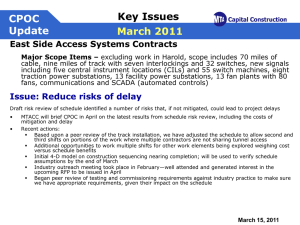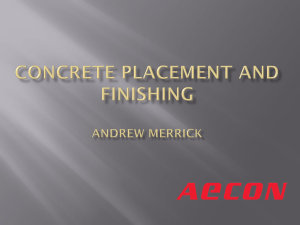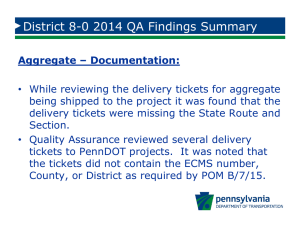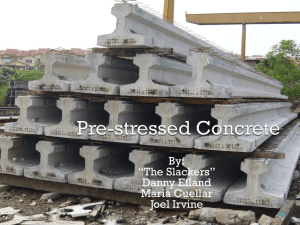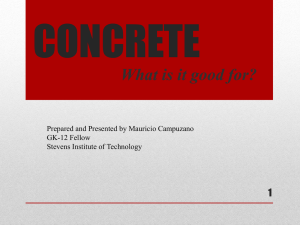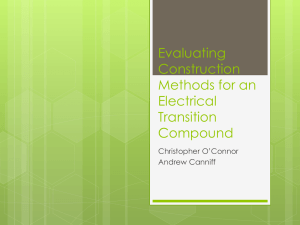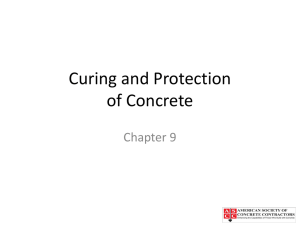Concrete Issues
advertisement
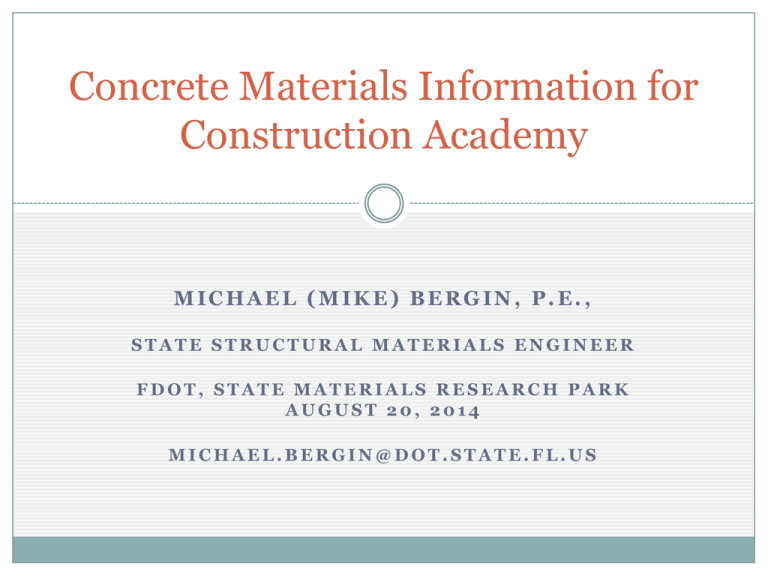
Concrete Materials Information for Construction Academy MICHAEL (MIKE) BERGIN, P.E., STATE STRUCTURAL MATERIALS ENGINEER FDOT, STATE MATERIALS RESEARCH PARK AUGUST 20, 2014 MICHAEL.BERGIN@DOT.STATE.FL.US Topics Fundamentals of Good Concrete A better understanding of w/c ratio Slump of Concrete Water added at the site Penalties Available water for hydration Drilled shaft concrete and slump loss Mass concrete Specification changes Topics 346 changes based on 1/15 lettings Performance Based Concrete Pavement, Section 350 Slab Replacement Concrete, Section 353 (proposed changes) Sampling Steel New Ideas, Concepts and Research Internal Curing Roller compacted concrete (RCC) Self consolidating concrete (SCC) Ground Glass in Concrete GTR in Concrete Water Cementitious Materials Ratio and the Velcro Approach What is the w/c ratio ? Cementitious Materials Includes: ◦ Cement ◦ Pozzolans, ◦ Type I, II, III Particle size; ∼ 25 to 40 microns Fly ash, Class F and C Ground glass Rice hull ash Sugar Cane Ash Highly reactive pozzolans Particle size, ∼ 0.1 to 50 microns Slag GGBFS, grade 100 or 120 Particle size, ∼ 20 to 40 microns Pozzolans and ‘Particle Packing’ Straight cement and high w/c (>0.41) ◦ ◦ ◦ Particles separated by high water content Shrinkage Excessive bleed water Straight cement and low w/c (≤0.41) ◦ ◦ Particles closer together, tighter bond A little more durable Cement and pozzolans with low w/c ◦ Particles ◦ closer together, size more distributed, very tight bond Durability has arrived High w/c Ratio Water Increases initial volume Collects in lens under the surface Lens is a problem when traffic is placed on it Lens may be under reinforcement Increase in ‘bleed water’ Delays finish work Unwanted surface conditions and less durable concrete Shrinkage Surface cracking Scaling High w/c Ratio Fines help reduce bleed water Cementitious plus fine aggregate 60% coarse/40 fines is a good ratio. Rate of bleed water evaporating is regulated by external conditions (weather) A need for curing Low w/c Ratio How much water is needed to hydrate cement? Concrete maintains its volume A little more is needed for pozzolans or slag Reduces the pathways for bleed water Still need some bleed water More durable concrete Increase in density Less surface problems on finished concrete Add Fly Ash or Slag We have additional fine particles for packing and to provide pozzolanic activity Particle packing helps minimize voids in the paste Pozzolanic activity -concrete continues to hydrate (react) continues as long as there is calcium, silica and moisture in the matrix. Cement and fly ash both provide calcium and silica. Moisture already available in mix and moist curing ??? Some method of curing. Add a low w/c ratio Best particle packing Less water between particles Additional moisture (if needed) comes with wet curing or covering the surface to prevent moisture loss. Wind Heat Dry conditions and low humidity Water/Cement Ratio Cement particle Cement particle High W/C Low W/C Hydration Hydration High w/c ratio equates to lots of shrinkage cracking Shrinkage Cracking Water Added at the Job and Slump of Concrete Sect. 346 Target Slump and Tolerance Range Here’s a helpful graphic to clarify the issue (346, Table 6) Graphic illustrates target slump value Slump Range TOLERANCE SLUMP RANGE (3”) REJECT 1-1/2” DRY 1-1/2” WET ACCEPT – WATER MAY BE ADDED TARGET SLUMP REJECT When the Contractor adds water… Determine the slump If within the Target Slump Value Perform other plastic properties; Air Temperature Determine w/c ratio 346-6: Control of Quality 346-6.4 Tolerances: When slump is outside the tolerance range, Make cylinders Contractor rejects concrete He notifies the concrete production facility to adjust the concrete mixture He tests each subsequent load and the first adjusted load from the plant 346-12: Penalty occurs… If contractor places concrete when any of the plastic properties are outside the limits of the approved mix design He not only assumes risk of placing non compliant concrete, the contractor is penalized the invoice price of concrete, unless the Engineer approves. On-going drilled shaft placement Large footer (don’t want a cold joint) Disposition of defective materials (DDM) is required The discussion of w/c ratios, slump, slump loss, and elapse time are a major concerns for drilled shafts. Slump Loss? Elapsed Time? Time it takes to loose slump - drops from 10” to 5” Indicates how long the contractor has to place the concrete, set bolts, remove temporary casing. to get slump, producer uses water reducing admixtures and water. Drilled Shaft Concrete should not look like this! Or this! Q: What is the minimum clear cover (in inches) over steel? Some Probable Causes? Concrete not workable? Slump loss not accurate for this placement? Need new slump loss? Contractor not ready for concrete? Rebar spacing too tight? Engineers increasing capacity Second truck delayed? How was the deficiency determined? High Slump Concrete high slump concrete (≥7.5 ”) may have lumps and balls. Use a grate with max opening size of 2.5” in either direction Placement continues but, Lumps and balls are removed Contractor still responsible for strength Engineer can make cylinders anytime Department personnel to monitor Notify DMO if balls and lumps are present High Slump Concrete If you see lumps and balls,… DMO will evaluate the plant to ensure compliance with QC plan Plan indicates how they are to batch high slump concrete DMO can verify if the plant was producing in compliance with their plan If problems persist, the DMO may revoke the plants QC plan 346 Changes FOR LETTINGS BEGINNING JAN 2015 Section 346-2 Materials 346-2.2 Type II cement replaced with Type II (MH), moderate heat Required for mass (v/sa ≥ 1.0) concrete placements 346-2.3 Fly ash or slag is required for all concrete. Not required for dri-cast precast elements. New cement type is added, Type IP Ternary blends allowed in all classes of concrete Highly reactive pozzolans (HRP) are identified (SF, Metak, UFFA) 346-3.1 General Substituting higher strength for lower strength Can be used in two applications if approved by the Engineer 1. For Structural Concrete a Higher Strength can be used in lieu of Lower Strength 2. Structural Concrete can be used in lieu of Non-Structural Concrete 346-3.1 General Acceptance of concrete is based on contract requirements. Say contract requires C-II, 3400 psi A higher strength (C-IV, 5500 psi) is substituted Compressive strength results are 5,100 psi Does the concrete pass or fail? 346-3.1 General 5,100 psi meets contract requirements Concrete is accepted at FULL PAY But wait a minute !!!! 346-3.1 General The minimum required for the C-IV was 5,500 psi - only achieved 5,100 Notify DMO that concrete did not meet mix design target strength DMO will investigate concrete producer QC Program issue, not acceptance issue 346-3.1 General Section 347 governs non-structural concrete Do not test concrete based on 346 Acceptance based on delivery ticket, signed by batcher and QC certifying minimum 2,500 psi 346-3.2 Drilled Shaft Concrete Allows for slump loss test to be performed in the lab Less than 30 cubic yards, or Less than an maximum elapsed time of 5 hours Concrete used during the summer, temp > 85F, perform slump loss test at hot weather conditions. 346-3.3 Mass Concrete Mass concrete is indicated on the plans (v / sa ≥ 1.0) Control concrete temperature Max 180F (> 180F, what happens?) ΔT≤ 35F (interior to exterior) Interior stays hot, exterior cools If exceeded, contractor must take action How would contractor control temp??? 346-3.3 Mass Concrete New language is added; Same size elements One plan can be used 2 elements could be placed at one time 2nd needs to be started within 1 hour of the first. Both need to be instrumented Why would we want both instrumented??? 346-5: Sampling and Testing Methods Table 5 Added testing requirements for self consolidating concrete (SCC) Also indicates that QC will use the same type of air meter as V. 346-5: Sampling and Testing Methods Table 5 – If pressure meter is used, must have an aggregate correction factor on mix design Curing facilities have capacity to hold all QC and V cylinders V will use same air meter and cylinder size as QC Can take entire concrete sample at one time from middle of load, ASTM C172 346-7 Mixing and Delivering Transit time, reject trucks exceeding the maximum transit time Typically 90 minutes (agitator truck, HRWR) Construction personnel need to notify the District Materials Office of concrete placements To witness complicated placements Mass concrete Structural Drilled Shaft To IA QC or V technicians 346-7 Mixing and Delivering • • 346- 7.3 Mixing at the Site: This is indicated in the Contractors QC plan. 346-7.7 Adding Water: Any water missing from the saddle tanks is; Assumed to be in the batch and • is added to the jobsite water on the delivery ticket and included in the w/c ratio. 346-7 Mixing and Delivering Changes No water added to truck after 130 revs Truck has started to place within 90 min. has 15 additional min to complete the placement If 120 min haul time already approved, no additional time allowed. 346-7 Mixing and Delivering 346-7.8 Sample Location: Sample Correlation required when contractor can’t sample at the point of final placement. Need 5 samples, one sample per load What is a sample? DMO will help with this process Bottom Up Pumping 346-8 Plastic Concrete Sampling and Testing Truck Mixer Identification Card? Inspector should request to see this. If no card, truck cannot deliver for FDOT, reject concrete Contractor is responsible to remove this if there are deficiencies with the truck that cannot be repaired immediately. He is to forward id card to DMO When any 5 loads within 2 days are outside the specified tolerances- notify DMO, they will suspend production from the plant! 346-9: Acceptance Sampling and Testing When a mix is used for a different application, the LOT is defined by that application. Class II concrete is placed for use as Class I Pavement. Lot size for this Class II concrete is defined as 2000 sy, or 1 days production, its placed as pavement 346-9: Acceptance Sampling and Testing Acceptance is typically a 50 cyd lot size 346-9.2.1 Acceptance Tests can be reduced to 100 yd3 if there is consistency in strength tests (same mix, same plant, same contract) Need 2 Sdev (95% of data) above the minimum required strength based on the class of concrete 346-9: Acceptance Sampling and Testing For Class IV or higher, need ten consecutive strength tests to determine reduced frequency For Class III or lower, need five consecutive strength tests to determine reduced frequency Data must come from an approved lab (Section 105) 346-9: Acceptance Sampling and Testing Need prior approval of the Engineer Provide data prior to approval CPAM has instructions on the process Usually includes the DMO to help verify data. Why would a concrete producer not want the contractor to use the “reduced frequency” option? 346-10 Investigate Low Strength Concrete The 10% (below minimum) was removed and is now 500 psi only. If the strength of the concrete is within 500 psi below the minimum required; the contractor cannot core to determine strength a pay penalty is applied . Why do we have this caveat?? Performance Based Spec. for Pavement Complete rewrite of Section 350 PB 350 Pilot Projects I-4, from SR 44 to I-95, Deland I-275, area north of I-4, Tampa 9B, Jacksonville PB 350 Mix Design Compressive strength (4000 psi) W/cm not to exceed 0.50 • Material sources must be approved ◦ Can use a commercial mix ◦ Mix will be approved by DMO; Requires LIMs entry PB 350 Mix Design Plant approval Central batch plant Develop Sdev for plant with 30 data points Previous data - OK Provides the overdesign needed for mix approval Ready mix plant Overdesign still required – Why?? PB 350 Equipment Slip form paver; ◦ On board vibrators frequency is calibrated recording device used to monitor frequency Forms may be used where needed; ◦ Must be steel, straight and designed for concrete. ◦ Curing compound spraying equipment, must be mechanically driven. PB 350 Placing Concrete Place concrete by single lane width or full width of the combined travel lanes Thickness cannot deviate by more than ½ inch Delivery ticket Still required (modified tix) for contractors using central batch plant, unit price/syd Required for each load of ready mix Addition of water does not apply unless concrete is delivered by ready mix truck PB 350 Sampling and Testing QC is temperature control of the concrete and making and curing cylinders Cylinders may need to be vibrated A LOT is 2000 syd or 1 days production Partial LOTs (<500 syd) are combined with previous LOT for acceptance purposes. Testing may be reduced to 4000 syd, with consistent strength data PB 350 Finishing and Curing Finish the concrete with a burlap drag. Curing will be with white pigmented curing compound 1 gal/ 200 ft2 If forms are used, apply curing compound to the sides of the concrete when forms are removed. Saw the joints when the sheen has left the concrete surface. We want to control where the concrete cracks! Add some other pics of shrinkage and other cracking Stress Crack PB 350 Thickness Core the pavement to determine thickness of concrete (ASTM C174), need 2 cores The department will trial the use of the Probe Method (FM) to verify the thickness Use 12 points to verify thickness by the probe method. The hope is to use this to verify thickness, instead of coring Concrete Probe (thickness) 350 Opening to Traffic Concrete strength ≥ 2200 psi Cylinders cured similar to the slab concrete. Maturity Method can be used to indicate concrete strength For opening to traffic Not for acceptance Changes to Section 353 What is 353 Concrete? Revising this specification to address current problems In some cases- high rate of cracked slabs in new concrete Slab replacement projects are on-going or scheduled to start in almost every district 353 Concrete is almost ready to be placed. What’s missing? 353 Issues Opening to traffic, contractor’s major goal (usually night work) If he places concrete until 4 AM Does not provide curing time for concrete Can’t limit truck traffic Can we limit contractor? Limit means and methods of contractor? Require a minimum curing time? 353 Issues Mixes are extremely “hot” Initial set, 15 to 30 min. Accelerators are used and are typically placed outside of recommended dosage rates Revisions needed to ‘cool’ the concrete Now this is HOT!! 353 Revision We’re revising Section 353 to; Provide construction personnel with guidance on the placement and curing of 353 concrete Ensure a low percent of failures. Record admixture dosage limit dosage to max dosage on tech data sheet. Sampling Steel on the project How is reinforcement steel sampled? How is post tensioning strand sampled? How are stressing bars sampled? Sampling Steel Project personnel need to collect; 3 pieces, at random by you. Mill certificate w/ Buy America clause Cert should identify the steel Place in envelope, firmly attached to steel Do not cut sample with a torch! Send 1 bar, hold 2 (a check may be needed) Any bar not selected by you is not random! No ‘test bars’, ‘splice bars’, or ‘FDOT test samples’ Sampling Steel Job Guide Schedule indicates amount of steel on the job Look for total quantity (usually in lbs) Take the total ÷ 2000 lbs to get tons Divide that number by 80 to get the samples needed Randomly sample during project Not while project is being certified! Sampling Steel Rebars (#3 to #18) A sample is 3 bars – 7’ long – Mill cert in an envelope attached to the sample 1 per 80 tons Submit 1 bar to SMO, hold 2 Sample most frequently used bar size If bar passes, give the other 2 bars to contractor, or discard. Foreign bars indicate country of origin Sampling Steel Post tension 7 wire strand A sample is 3 strands, 5’ long Mill cert in an envelope attached to the sample 1/ shipment Send 1, hold 2 (may need a check sample) Again, must be a random sample Sampling Steel Threaded stressing bars A sample is 3 bars, 4’ long Mill cert in an envelope attached to the sample 1/ heat/ shipment/ job or JGS Send 1, hold 2 Random, selected by you Sampling Steel - Review Take 3 pieces of steel from project at a frequency indicated in JGS. No torching of bars Send 1 to SMO, hold 2 Send mill cert in envelope attached to steel Sample to match mill cert Internal Curing of Concrete Use light weight aggregate About 20% of the total fines in mix Provides additional moisture in the mix Does not “bleed” out during normal curing Remains to provide the additional moisture needed to provide long term hydration Used by pozzolans long after 28 day strength is determined Roller Compacted Concrete Use cement, good blend of coarse aggregate and a little water Batch materials in a pug mill Delivered in a dump truck Placed into a spreader or a high density asphalt paver. Rolled to a specific density with a steel wheel roller. Can be smoothed with a rubber tire roller if needed Finished surface may be rough. Self Consolidating Concrete Very fluid Self levels Very finicky Sensitive to temperature Changes to water Water additions to load Changes to aggregate moisture Lab Test Methods for SCC To verify and approve the mix; ASTM C 1610 - Static Segregation of SCC using Column Techniques ASTM C 1712 – Dynamic Segregation of SCC (new device) Static Segregation Test (ASTM C1610) Dynamic Segregation Test Field Test Methods for SCC To accept concrete at the project; ASTM C 1611 - Slump Flow of SCC ASTM C 1621 - Passing Ability of SCC by J-Ring Conventional tests; Percent air, Air or pressure meter Temperature Slump Flow of SCC (ASTM C1611) Passing Ability of SCC through the J Ring (ASTM C1621) Chap.8.4 of Materials Manual Prestressed and Precast concrete A revision to 8.4 allows a change in the slump flow of SCC from 25” to 27” ± 2.5” Provides a more fluid concrete to reduce bug holes and voids in highly reinforced prestressed elements Ground Glass in Concrete Glass not used in the past- due to ASR What is ASR? New research indicates if ground small enough, no ASR The ground glass actually reacts like fly ash Can use any color glass, except for Pyrex (very reactive) Glass has to be cleaned before use Ground Tire Rubber in Concrete Several particle sizes were used The best size is a crumb rubber similar to the size used in asphalt. Use about 20% maximum replacement of fine aggregate. Provides a reduction in strength (less brittle) The MOE is lower, so slabs are able to move a little The effort helps to reduce the amount of rubber tires going into landfills. LIMS Updates MAC is the new system, and its coming! But if you have any questions about how to enter a sample in LIMs,…. LIMS Look up the information at; “Instructions for Samples for Structural Materials” on the SMO website http://www.dot.state.fl.us/statematerialsoffice/ laboratory/lims/resources/tutorials.shtm My Request from You In my evaluation, tell me: About concrete topics that should be discussed in this session Are there portions of 346 that are confusing and need clarification? Is there additional concrete training or information that are of special interest to you or others? Thanks for your time!


